Reviewed feature article
Rossman, A.Y. 2002. Flora W. Patterson: The first woman mycologist at the USDA
The Plant Health Instructor. DOI: 10.1094/PHI-I-2002-0815-01.
Revised, 2012
Amy Y. Rossman
Systematic Botany and Mycology Laboratory
10300 Baltimore Ave.
Beltsville, MD 20705-2350
Amy.Rossman@ars.usda.gov
The recent APSnet Feature article on Effie Southworth, the first woman plant pathologist hired by the USDA in the late 19th century (see APSnet Feature on Effie Southworth), began with a letter from George P. Clinton to his former advisor William Farlow at Harvard University. Besides Effie Southworth, the letter also mentions Flora Wambaugh Patterson as one of the women plant pathologists who worked at the turn of the century and "spread out into a dozen or more!"
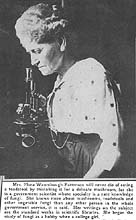
Fig. 1. This brief article and photograph of Patterson appeared in the
Washington Star on December 9, 1917 |
Flora Patterson started service in the government late in life at the age of 48 (Fig. 1), in contrast to Effie Southworth, who began her career with the USDA in 1887 soon after competing her studies at Bryn Mawr College. In 1896, and for the next 27 years, Patterson worked at the Bureau of Plant Industry in Washington, D.C. She began her scientific career out of necessity after her husband became disabled and eventually died leaving her with two young children in a time without a government safety net. Her legacy encompasses systematics research on several groups of plant pathogenic fungi, inspection of agricultural commodities including the famous Japanese cherry trees on the Mall in Washington, DC, and, most significantly, the recognition of the need to build a reference collection of fungi and the addition of over 90,000 specimens to the U.S. National Fungus Collections.
Flora Wambaugh Patterson was born in Columbus, Ohio in 1847 where her father was a Methodist minister. She was interested in fungi as a hobby while still a young girl (19). She studied at Antioch College, earning an A.B. degree in 1865, and later, in 1883, received an A.M. degree from Wesleyan College, Cincinnati. In August, 1869 she married Captain Edwin Patterson and had two sons. A few years later her husband was injured in a steamboat explosion that left him helpless and the family without a breadwinner. For the next ten years until he died, she cared for her husband and their children. After his death, Flora Patterson took up the study of biology at the State University of Iowa where her brother was a professor. In 1893, she moved east and placed her sons in a college preparation school while planning to continue her own studies at Yale University.
“Thinking all conditions for pursuing work at Yale had been arranged, she went there only to find the doors closed against her, women not being eligible at that time. In spite of the keen disappointment and inconvenience, she persisted in her desire to continue botanical investigations, and, going to Cambridge, registered for work at Radcliffe College” (6).
For the next three years Patterson took courses in botany at Radcliffe College while working as an assistant in the Gray Herbarium at Harvard University. At the Gray Herbarium, one of the foremost botanical repositories of the day, she received her training in mycology, plant pathology, and care of the fungal collections.
|
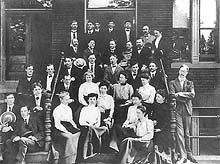
Fig. 2. Staff of the Bureau of Plant Industry in front the USDA building, ca. 1900s. Flora Wambaugh Patterson is seated in the front row on the left. Beverly Galloway is standing to the right of the stairs. Courtesy of the National Archives (Click image for
larger view).
|
In 1895 Patterson took the Civil Service examination and was appointed Assistant Pathologist in the Section of Vegetable Pathology of the USDA in Washington, DC. Recognizing the importance of the burgeoning USDA fungal collections, Beverly T. Galloway hired both Franklin Sumner Earle and Flora Patterson to assist with the herbarium work. Earle lasted only one year, leaving for Alabama and eventually moving to the newly established New York Botanical Garden. On the other hand, Patterson stayed at the USDA almost three decades during which time she succeeded in increasing the reference specimens in the U.S. National Fungus Collections from 19,000 to 115,000 (4). When the Bureau of Plant Industry was formally established, Galloway became Chief and, soon thereafter, Mrs. Patterson was appointed Mycologist in Charge of Mycological and Pathological Collections, a title that she held until her retirement in 1923 (Fig. 2) (6).
Plant Quarantine Work - New Diseases Arriving
One of Patterson’s major responsibilities was the inspection of imported commodities for non-native, potentially invasive fungal pathogens. In 1906 a formal plant inspection program was initiated in which Patterson and her three employees were charged with detecting and identifying fungal diseases. Many unusual and unknown fungi were found and the mycologists worked tirelessly on the identification of these fungi as well as methods for their eradication. In this role Patterson was involved in several of the major fungal pandemics in the U.S. including the chestnut blight disease that altered the landscape of the eastern deciduous forests (see APSnet Feature on chestnut blight). Among their interceptions was the dangerous potato wart disease caused by
Synchytrium endobioticum, which they identified for the first time on potatoes for import into the U.S. This fungus remains the subject of considerable plant quarantine activity.
One of the more memorable episodes in her plant quarantine activities concerned the Japanese flowering cherry trees that were given to the United States as a present from the Mayor of Tokyo. Upon the arrival of 2,000 highly prized plants in January, 1910, the exotic trees were found to be infected with numerous fungi and insects (8). Realizing the potential danger these organisms posed to U.S. agriculture, Patterson and her colleagues including Nathan Cobb, a nematologist, and J.G. Sanders, an entomologist, took a politically unpopular position and advised that the cherry trees be destroyed. In a letter (Fig. 3) written by Patterson about the infected trees, she noted that in addition to crown gall “present on 45% of the trees ... the girdling of five trees apparently has resulted from the attack of a
Pestalozzia sp…It is impossible to decide with the limited time available for research if the
Pestalozzia is of an indigenous species.” Despite the passing of almost a century, members of the genus
Pestalozzia (now spelled
Pestalotia) and its segregate genera are still very difficult to identify to species. The unidentified specimen of
Pestalotia sp. from the first set of cherry trees still resides in the U.S. National Fungus Collections (Fig. 4). The three USDA scientists who inspected the first shipment of Japanese cherry trees were able to convince the U.S. government of the danger posed by these exotic organisms. The entire lot of trees was burned in a bonfire on the Mall in Washington, D.C. (Figs. 5 and 6). A carefully worded, diplomatic letter was composed and sent to Japan. Eventually a second set of thoroughly fumigated trees was shipped and arrived free of insects and diseases. These new cherry trees still adorn the Tidal Basin in downtown Washington, DC (Fig. 7).
|
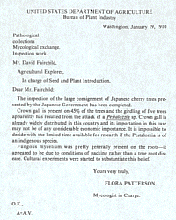 | |
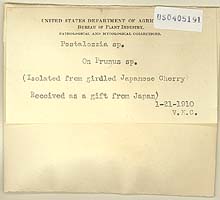 |
|
Fig. 3. Letter written by Flora W. Patterson about the plant pathogens found upon inspection of the Japanese cherry trees shipped from Japan to Seattle and then transported via railroad to Washington, DC (8) (Click image for
larger view). | |
Fig. 4. Specimen of a fungus on the Japanese cherry trees that is still unidentified to species. The specimen was collected and identified by Vera K. Charles, one of Patterson’s assistants, and is part of the collections at the U.S. National Fungus Collections (BPI) (Click image for
larger view). |
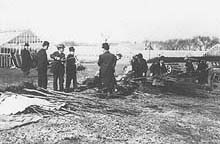
Fig. 5. USDA plant pathologists and entomologists inspecting the first set of Japanese cherry trees that were found to be infected with exotic fungi and insects (8) (Click image for
larger view). | |
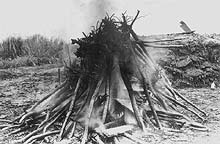
Fig. 6. The first set of Japanese cherry trees being burned on the mall following the discovery of potentially harmful plant pathogens and insects (8) (Click image for
larger view). |
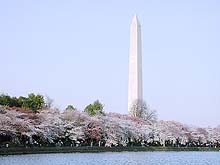
Fig. 7. Japanese cherry trees flowering around the Tidal Basin with the Washington monument in the background, Washington, DC (Courtesy of David F. Farr) (Click image for
larger view). |
Patterson also played a role in the identification of the chestnut blight fungus following its initial discovery and subsequent rapid spread along the eastern seaboard. Chestnut blight caused by
Cryphonectria parasitica (=Endothia parasitica) (Fig. 8) was initially discovered on the chestnut trees at the Bronx Zoological Park in the Bronx, New York in 1904. Specimens were sent to Patterson for identification (3). By 1907 chestnut blight had spread up the Hudson River to Poughkeepsie, New York and south to Trenton, New Jersey. Despite urgent calls to implement stringent control measures, the disease eventually spread throughout the eastern United States killing nearly all of the mature chestnut trees that dominated the deciduous forest. Even today chestnut trees can be seen only as sprouts or as half-dead trees that become cankered and die as they approach maturity, never producing viable chestnuts (2). Eventually the incident involving the Japanese cherry trees and the threat of potato wart disease as well as the catastrophic introduction of the chestnut blight fungus led to the passing of the Plant Quarantine Act of 1912 (5) aimed at preventing the inadvertent introduction of harmful, invasive organisms.
|
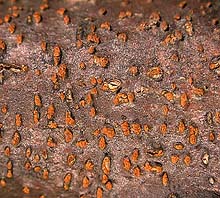
Fig. 8. Chestnut blight fungus (Courtesy of David F. Farr) (Click image for
larger view). | |
Having seen the devastating effects of newly introduced fungi, Patterson strongly defended the need for the inspection of agricultural commodities brought into the United States. In 1914, apparently as a cost-cutting measure, the mycologists in the Division of Mycology and Mycological Collections, now four in number of whom three were women, were threatened with transfer to an organization at which they would no longer inspect incoming plant germplasm. Patterson wrote in response:
“It is significant that each fungous disease which has been called to public attention through the Department or by other workers had first been noted by the inspectors either directly or by means of correspondence. As instances of this nature may be mentioned English potato scab, silver scurf, chestnut blight disease and citrus canker, specimens of all of which had been secured by correspondence or requests for mycological assistance” (13).
Truly, Patterson was at the frontline of defense against fungal invaders! She recognized the importance of plant quarantine activities to help prevent the inadvertent introduction of invasive pathogens and the need to base those inspection activities on reference specimens (9). This activity continues to this day and is made even more important with the threat of deliberate release of crop bioterror agents into the food supply.
Upbuilding of the U.S. National Fungus Collections (BPI)
One of Patterson’s accomplishments from which many mycologists and plant pathologists still benefit is her contribution to the development of the U.S. National Fungus Collections. In the course of her inspection work and discovery of many unusual fungi, Patterson saw the critical need for a reference collection of fungi. Initially the USDA collections of plants and fungi were combined with those of the Smithsonian Institution. They were housed in the “famous old red building on the Mall which sheltered all of the activities of the Department of Agriculture in Washington for many years after its erection in 1867” (17) (Fig. 2). In 1893 the plant collections were returned to the Smithsonian. The fungal collections of the Smithsonian remained with the USDA to form the combined USDA-Smithsonian fungal collections. Patterson and her successors expended considerable effort building what is today the largest reference collection of fungi in the world, the U.S. National Fungus Collections, now located in Beltsville, Maryland.
In 1896 Patterson took over as the major contributor and keeper of the USDA fungal collections following her two famous predecessors. F. Lamson Scribner, the first federal government plant pathologist, went on to become Chief of the Section of Vegetable Pathology, and Beverly T. Galloway became Chief of the Bureau of Plant Industry (5).
In the years just prior to Patterson’s arrival, Galloway bemoaned the loss of mycologists to the “new field of plant pathology”:
"The glamour of field service in phytopathology…was irresistible so that our collections and herbaria were beginning to languish and our mycological technique becoming rusty from use….It was the conviction of my colleagues of the period that our only hope was to find a good man, rich in experience and so wedded to mycology and its attendant interests that nothing could swerve him from the then recognized beaten path" (7).
Fortunately for mycology, that path was filled by Flora Patterson who was hired expressly to take charge of the fungus herbarium. During her tenure as Mycologist, the USDA fungal collections increased in number to more than 114,000 fungal specimens (4). John Stevenson, Director of the U.S. National Fungus Collections from 1927-1960, wrote that Patterson had “for 28 years devoted herself unceasingly to the upbuilding of the collections ... ” (17). In addition to receiving, collecting and identifying many fungal specimens associated with imported agricultural commodities, she actively sought out fungal specimens from other scientists as a means of documenting new records of fungi. Writing to H.B. Humphrey, USDA plant pathologist working on cereal diseases, she thanked him for his rust specimens collected in the Western United States and concluded that “It would be extremely gratifying if all of the pathologists of the Bureau would be so thoughtful in depositing material here.” (16). Issues such as documenting research with voucher specimens is still a topic that is very much alive today (1).
Patterson communicated with scientists all over the world seeking fungal specimens that were available for purchase or exchange. This was a time when examination of accurately identified specimens served as the primary reference tool for the identification of fungi, rather than the scientific literature. Without copy or fax machines, literature was difficult to obtain. Instead, sets of reference specimens called exsiccati were collected, identified, assembled and sold to institutions. This was a source of livelihood for many of the early American mycologists including J. B. Ellis, H. W. Ravenel, and A. B. Seymour (18). In addition to obtaining funds for the purchase of exsiccati sets and increasing the number of reference specimens, Patterson and her staff developed card files of information about fungi. These files include an extensive host index for all collections as well as all published reports of fungi associated with plants and a file of all described fungi and their synonyms. These data files were maintained as cards until the advent of computerized databases in the early 1980s. Patterson’s legacy continues as databases of information about plant-associated fungi that are available on the Web for the use of plant pathologists, mycologists, and plant regulatory officials (http://nt.ars-grin.gov). Patterson organized programs and assembled a staff that notably influenced subsequent development of the U.S. National Fungus Collections. Emphasis was on the systematics of plant pathogenic fungi, especially those of plant quarantine significance, a priority that continues to this day.
|
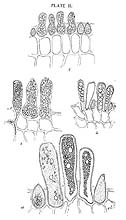
Fig. 9. Line drawings by Patterson of asci with ascospores of
Taphrina spp. (10) (Click image for
larger view). |
Research on Plant Pathogenic Fungi
Early in her career Flora Patterson published one of the few accounts of the leaf parasitic fungi belonging to the Exoascaceae that attack living leaves (10,11). These fungi are now known as species in the genus
Taphrina causing such diseases as peach leaf curl. The delicate line drawings of the naked asci accurately represent the structures still used to identify these fungi (Fig. 9). Patterson identified about 800 specimens in the U.S. National Fungus Collections. Many of these specimens were microfungi on exotic tropical plants growing in the USDA greenhouses, newly discovered pathogens on crop plants, or fungi found during inspection of agricultural commodities at ports of entry. Based on the specimens obtained while inspecting newly imported commodities, Patterson described a number of new species and one new genus (12). The cause of witches' broom of bamboo was described as a new genus and species,
Loculistroma bambusae (12). She and her colleagues worked to develop control measures such as fumigation to control pineapple rot caused by
Thielaviopsis paradoxa (12) (Fig. 10).
|
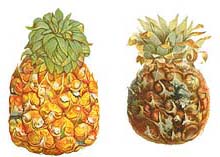
Fig. 10. Pineapples inoculated with
Thielaviopsis paradoxa, cause of pineapple rot. Fruit on right sprayed with spores shows less resistance to the disease than the fruit on the left inoculated by incision method (12) (Click image for
larger view). | |
Her most widely distributed publications were two bulletins, one entitled “Mushrooms and Other Common Fungi” and the other “Some common edible and poisonous mushrooms” in which common fleshy fungi were described and illustrated (14,15). Included was a discussion of their edibility or poisonous nature as well as recipes such as deviled mushrooms, oysters with mushrooms, mushrooms baked with tomatoes, and even mushroom catsup (Fig. 11).
|
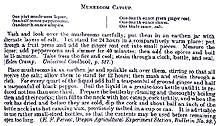
Fig. 11. Recipe for mushroom catsup from Patterson's bulletin, "Mushrooms and Other Common Fungi" (15) (Click image for
larger view).
| |
Patterson retired at the age of 75 having contributed enormously to the development of the U.S. National Fungus Collections as well as the knowledge of numerous plant pathogenic fungi associated with imported agricultural commodities. Her vigorous activities resulted in a strong mycological tone to the work at the USDA that continues to this day. After retirement she lived with her son in New York City where she died at the age of 80. During her tenure at the USDA Bureau of Plant Industry three more women mycologists were hired to work under Patterson. It was indeed true that women mycologists were “spreading out into a dozen or more” -- well, at least to four by the end of 1923.1
1All of these dedicated women mycologists worked for several decades at the USDA: Vera K. Charles 1903-1942, Anna Jenkins 1912-1952, and Edith Cash 1913-1958.
Additional Resources
Association for Women in Science
Maria Mitchell Association
National Women’s History Project
References
1. Agerer, R., Ammirati, J., Baroni, T. J., Blanz, P., Courtecuisse, R., Desjardin, D. E., Gams, W., Hallenberg, N., Halling, R., Hawksworth, D. L., Horak, E., Korf, R. P., Mueller, G. M., Oberwinkler, F., Rambold, G., Summerbell, R. C., Triebel, D., Watling, R. 2000. Always deposit vouchers. Mycological Res. 104:642-644.
2. Anagnostakis, S. L. 1987. Chestnut blight: The classical problem of an introduced pathogen. Mycologia 79:23--37.
3. Anderson, J. P., and Rankin, W. H. 1914. Endothia canker of chestnut. Cornell University, Dept. of Plant Pathology Bulletin 347
4. Benjamin, C. R. 1963. The National Fungus Collections. Plant Science Bulletin 9:1-6.
5. Campbell, C. L., Peterson, P. D., and Griffith, C. S. 1999. The Formative Years of Plant Pathology in the United States. American Phytopathological Society, St. Paul, MN.
6. Charles, V. K. 1929. Mrs. Flora Wambaugh Patterson. Mycologia 21:1-4.
7. Galloway, B. T. 1928. Flora W. Patterson 1847-1928. Phytopathology 18:877-879.
8. Jefferson, R. M., and Fusonie, A. E. 1977. The Japanese flowering cherry trees of Washington, DC; a living symbol of friendship. National Arboretum Contribution No. 4.
9. Palm, M. E. 1999. Mycology and world trade: a view from the front line. Mycologia 91:1-12.
10. Patterson, F. W. 1894. Species of
Taphrina parasitic on
Populus. Proc. Amer. Assoc. Advan. Sci. 43:293-294.
11. Patterson, F. W. 1895. A study of North American parasitic Exoascaceae. Iowa Univ. Bull. Lab. Nat. Hist. 3:89-135.
12. Patterson, F. W., Charles, V. K., and Veihmeyer, F. J. 1910. Some fungous diseases of economic importance. I.-Miscellaneous Diseases. II. Pineapple rot caused by
Thielaviopsis paradoxa. USDA, Bureau of Plant Industry, Bull. No. 171.
13. Patterson, F. W. 1914. Letter to Dr. Wm. A. Taylor. November 9, 1914. National Fungus Collections General Correspondence P-Q through 1959.
14. Patterson, F. W., and Charles, V. K. 1915. Mushrooms and other common fungi. USDA Bulletin No. 175.
15. Patterson, F. W., and Charles, V. K. 1917. Some common edible and poisonous mushrooms. USDA Farmer’s Bulletin No. 796.
16. Patterson, F. W. 1922. Letter to H. B. Humphrey. February 1, 1922. National Fungus Collections General Correspondence P-Q through 1959.
17. Stevenson, J. A. 1955. The National Fungus Collections. Taxon 4:181-185.
18. Stevenson, J. A. 1971. An account of fungus exsiccati containing material from the America. Beihefte sur Nova Hedwigia 36:1-563.
19. Washington Star. Recognition: Fellow of the American Association for the Advancement of Science and Fellow of the Botanical Society of America as well as a member of five other professional societies included the American Association of University Women. December 9, 1917.
Acknowledgements
Special thanks to Dr. David Farr, USDA, ARS, National Fungus Collections, Beltsville MD 20705-2350; Don Pfister and Lisa DeCesare, Farlow Archives and Herbarium, Harvard University; and Paul Peterson and Jean Ristaino, NC State University, for providing archival and bibliographical information for this feature.
